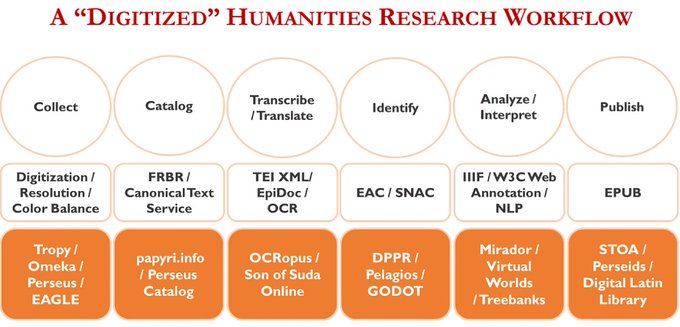Emerging Digital Infrastructure for the Humanities
Graphic display of digitized humanities research workflow.

Summary
In this article, Donald J. Waters, former senior program officer of the Andrew W. Mellon Foundation, advances the idea that national as well as private funding "combined with those of scholars, technologists, librarians, archivists, and their institutions, have resulted in a digital infrastructure in the humanities that is now capable of supporting end-to-end research workflows."
By “digital infrastructure,” he specifically means the collection of standards, software, digital content, and expertise that directly supports scholarly research", further qualifying the scope of the essay by noting that, "At one level, there are platforms of various kinds for digital search and messaging; other levels include networking and storage protocols and technology. These other layers of digital infrastructure are not directly addressed..." He also notes that the capabilities of this infrastructure are unevenly distributed.
A key quote is:
With the emergence of a functional digital workflow, researchers in classical studies and other humanities disciplines have strived in these ways to produce digital analogs of the article, monograph, and critical edition, which mark the traditional end points of research efforts and represent the badges of success that scholars usually seek. However, it has not escaped the most digitally savvy researchers that these three kinds of publication are not the only and may not even be the most important research outcomes for the digital future of scholarly communications [24]. One scholar has observed that the digital research workflow has created a “distributed architecture” for publishing [54]; others have noted that it has contributed an “increasing diversity and complexity of content” to the scholarly record [72]. In other words, the digital processes described in the previous sections—collection, cataloging, transcribing and translation, identifying, and analyzing and interpreting—each lead to the creation of or contribution to key scholarly products, often in the form of specialized databases. These works make public and effectively publish knowledge that is of interest in and of itself to audiences beyond the researchers who compile it.
These new, digital forms of what might be called “intermediate” publications resemble the emerging processes of data publication in some sciences and social sciences, and they have depended on the rise of important new divisions of labor in the humanities research enterprise.
However, as noted in the article abstract, "Because further refinements and additional capacities are still much needed, the article concludes with a discussion of key priorities for future work."
Waters' suggested priorities for future work include:
- improved interoperability;
- a readiness to accommodate expanded usage; and
- ensured sustainability.
This article "The Emerging Digital Infrastructure for Research in the Humanities" was made available online on October 7, 2022. It was published by the International Journal on Digital Libraries (Springer, 2022)
Citation: Waters, D.J. The emerging digital infrastructure for research in the humanities. Int J Digit Libr (2022). https://doi.org/10.1007/s00799-022-00332-3